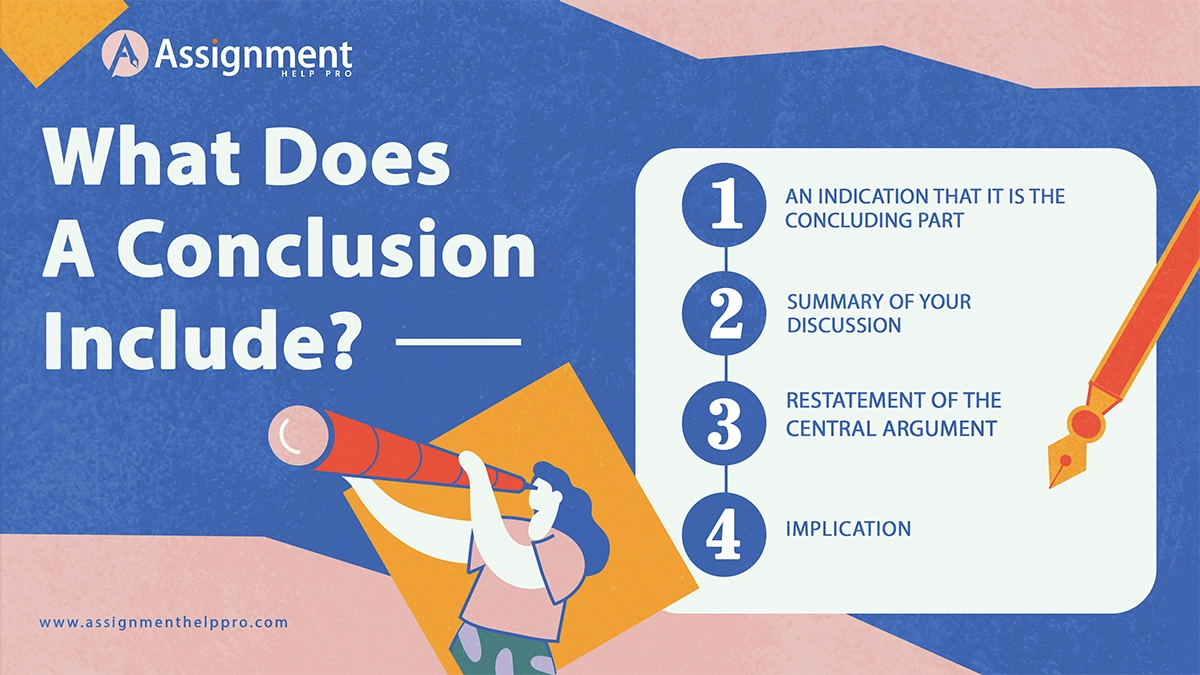People often consider the conclusion to be one of the most complicated sections to write in an essay. However, no one can disagree that conclusions are one of the most essential aspects of a paper. Moreover, they play a significant role in providing clarity and insight on the topic. Nonetheless, if you are struggling to write an effective conclusion, then this blog will be of great help to you. From here, you can learn the minute details of writing a conclusion. Plus, broaden your knowledge on its various types and do’s and don’ts of writing a conclusion.
What Is A Conclusion?
Before you write a conclusion, you must have a clear idea of the basic concept of a conclusion. A conclusion is the last part of your essay. It summarizes the ideas you have covered in your assignment and gives your readers an idea for further research on the subject. Apart from that, you can expect a closure to the topic of discussion, a recommendation or solution, or a comment on the broader implication of the area of study.
When to Use a Conclusion?
You can use conclusions at any time of writing a document. It can be a part of the essay, report, article, or research paper or simply it may explore an idea, issue, or event. To state it clearly, the conclusion answers the question “So what”. It explains the central point of the essay and gives readers a solution, question, or insight on the subject that restates why the conclusion is important.

What Does A Conclusion Include?
You cannot visualize how to write a conclusion unless you are sure of what to include in it. Hence, when you write a conclusion ensure that it has the following components:
· An indication that it is the concluding part
Your readers will not know whether they have reached the closing part, if you don’t use a subheading like “conclusion’ to indicate the end to your writing. In that case, begin the last part of your document with simple and clear signposts like “While,” “since”, and “ultimately”.
· Summary of your discussion
You can echo the purpose of writing your document as you have highlighted in the introduction of your writing.
Example: The paper critically explored the relationship between X to that of Y
· Restatement of the central argument
Use this section to reflect upon the idea of the thesis statement as you have mentioned in the introduction.
Example: The discussion has highlighted the main…
· Implication
In this section, you can recommend for further research and practice or answer a question for “then what“.
Example: It may be beneficial to investigate further…
Also Read: Best Conclusion Starters For Writing a Concluding Paragraph
How to Write a Conclusion?
If you are confused about how to write a conclusion, execute the following steps:
Step 1: Revise the Thesis Statement
Start your conclusion by demonstrating your thesis and state what the readers must take away from your paper. To do the same, remind the readers of the ideas you have expressed previously in the introductory thesis. It will help you to show your readers the impact of your arguments along with the evidential support from the thesis.
Suppose this is the original thesis:
Permitting students to go to the library during lunch enhances campus life and helps with academic achievement. It is because it gives confidence to students to read, allows students to begin assignments quickly, and presents a sanctuary for students who eat alone.
Then, you can restate the thesis as:
Evidence proves that learners who have admission to their school’s library during lunch explore more volume of paperbacks and are more on the verge of completing their homework. Plus, students are not obligated to eat alone.
Step 2: Sum up your arguments in 1-2 lines
In the next step, provide evidence to your readers to support the restated thesis statement. However, don’t list the main arguments in bullets. Instead, explain their role in supporting the restated thesis. Now, to support the restated thesis mentioned above, you may restate the arguments as:
In keeping with the data, students looked for more books when they were permitted to enter their library for the duration of lunch. They used that time to research asked for assistance from their friends, classmates, or library assistants, and informed feeling less alone at lunchtime. This highlights that opening the doors of the library during lunch can perk up student life and school performance.
Step 3: Make your reader wonder about your subject
Conclude with a statement that makes your readers ponder over your paper topic. Think about how you want your reader to feel after they finish reading your copy. You have the power to induce the same feeling through the appropriate use of the last sentence. Here are a few examples:
- Call your reader to action
If you want your readers to take action immediately, you may use sentences like:
“By cooperating with school superintendents, Greenland ISD can enhance educational accomplishment by allowing students to utilize the library during lunch.”
- End with a warning
To make your readers alert of negative consequences you may end your writing with statements like:
“If students are not permitted to utilize the library during lunch, they will fail to benefit from a precious learning prospect they will never get back.”
- Evoke an image
To remind readers of the positive impact, you can take the call to end your sentences like:
“Next year, students at Greenland could be assembling around a table in the library going through the books or expanding the knowledge of their minds.”
Read More: Learn Various Approaches on How to Restate a Thesis
Types of Conclusion
Though various types of documents use different types of conclusions, all of them serve one of these three essential functions:
· Summarization
This style is frequently used for developing technical subjects using a more clinical tone, like in surveys, definitions, and reports. Since it rephrases the key thoughts of the essay, you may mostly use it in longer documents where readers you have to remind a reader about the essay’s main points. Therefore, you should never use reflexive references or subjective thoughts (like “in my opinion” or “I feel”) for this type of document.
· Editorialization
Editorialization is primarily used in essays where there is a controversial topic, a personal connection, or an appeal to persuade the reader. This style incorporates the writer’s commentary about the subject matter and often expresses their investment in the issue being discussed. This type of conclusion will use an anecdote and a conversational tone to draw attention to concerns, interpretations, personal beliefs, politics, or feelings.
· Externalization
This method is the most frequently used type of conclusion. You can use it to deal with essays that are built on a very complicated subject. Externalization conclusions help to transition into a relatable but separate topic that helps readers to further expand the discussion. This conclusion leads to the development of ideas for a new introduction with a potential new thesis. Hence, a new essay can be developed through this conclusion.
What to Avoid In a Conclusion?
When you consider how to write a conclusion, keep these things out of your conclusion body.
- Steer away from establishing the thesis, with novel ideas or evidence for the first time. If you find you have included a new point in your conclusion, weed them off and place them into one of the body paragraphs in your document.
- Ensure that you employ a tone that is not different from the rest of the paper.
- Avoid starting the conclusion with expressions like “in closing,” “in summary” or “in conclusion”. It is rather outmoded and unnecessary.
What to Incorporate In a Conclusion?
The function of a conclusion is to restate the arguments and thesis of the academic assignment. In other words, it presents a good judgment of finality and implies that you have achieved the goal of writing the piece. Here are some important aspects to bring in your conclusion to ensure its usefulness:
- End the essay on an optimistic note
- Exchange a few words on the significance of your ideas and the subject matter
- Present the reader with a feeling of closure
- Go over and sum up your main points
- Reshape and then reaffirm your thesis statement
What Does A Conclusion Outline Look Like?
A conclusion outline includes the following points:
- Topic sentence – to repeat the thesis statement
- Supporting sentences – to explain the significance of ideas and how are they connected to the thesis
- Closing sentence – give your final word on the subject
Also Read: Get Complete Guidance on How to Write a Counter Argument
Example of a Conclusion
Here is an illustration of a valuable conclusion paragraph:
“Though there has been much dispute on the topic, it is evident that self-governing leadership is the best type of management for the contemporary workplace. This is made apparent by the pieces of evidence that over the last century, employees have turned out to be more and more educated and proficient. Additionally, there is a rising stress on sovereignty, creativity, and free thought, giving a sense that team members comprehend that they have something valuable to add that could present a significant perspective. It is because of these grounds that democratic leadership, where input and contradictory judgments are welcome, should be adopted in most organizations.”
Conclusion
By now you must have an idea of how to write a conclusion. However, if you are still puzzled about how to make an effective conclusion or need help developing a high-quality paper, get in touch with us immediately.



